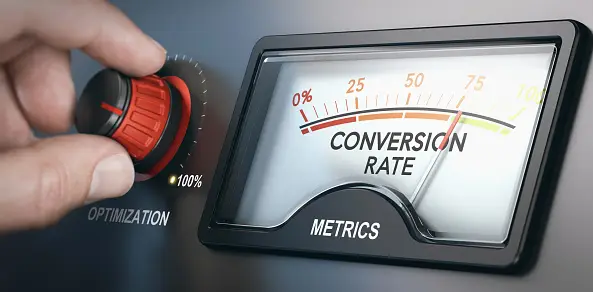Using conversion rates, digital marketers measure website traffic, marketing campaigns, and conversions. Conversion rate = conversions/visitors. An e-commerce site with 200 monthly visitors and 50 sales has a 25% conversion rate.
Any desired user action is a conversion. This can range from a CTA click to a purchase and new customer. Multiple conversion goals on websites and apps have different conversion rates.
Why are conversion rates significant?
Conversion rates help you evaluate the website and app performance. Knowing what percentage of users are completing your business’s goals lets you evaluate your site or app’s success and identify areas for improvement.
Increasing your conversion rate boosts sales with the same traffic. If you spend $1,000 monthly on advertising to get 500 visitors, doubling your conversion rate doubles your ad spend. You can then cut your ad spend and get the same benefit or invest the extra revenue in new ad programs.
Conversion rates can fluctuate due to many factors. New messaging or SEO can change conversion rates. While higher conversion rates are generally better, the more advantage you take of your traffic, not all traffic sources are created equal and can still contribute to more new customers even with lower conversion rates. Organic traffic converts better than display ads because searchers have more intent than banner clickers.
measuring the different kinds of conversion rates
Form fills, downloads, and clicks determine conversion rates.
Shopping cart clicks, purchases, and e-commerce conversion rates
Blog articles read (scroll tracking) divided by search traffic can measure organic search conversion rates.
Direct messages divided by followers can calculate social media conversion rates.
The click-through rate is calculated by dividing impressions by banner clicks.

How do different things affect conversion rates?
Many factors can affect conversion rates, including:
App and website visitors by channel and medium
Form fills, purchases, etc.
Online shopping varies by country.
Landing page messaging
Website or app optimization
Smartphones, tablets, and desktops
User experience usually boosts conversion rates.
The last one—user experience—is crucial. If you’re taking conversions from one action and converting them elsewhere, adding elements to your website or app may not improve conversion rates. Constantly monitor overall and action-specific conversion rates. You want net-positive conversion improvements, not subtracting to convert elsewhere.
Elements with high conversion rates but poor user experience include:
Popups boost page conversions but lower them elsewhere.
Interstitials that interrupt a blog reader
Dark patterns, which mislead visitors into converting.

How to measure the conversion rate?
The standard conversion tracking method is:
total visitors/conversions
Dissect that. “Visitors” refers to all website visitors, while “conversions” are all website actions. They are dividing one by the other yields a percentage or conversion rate.
Conversions include purchases, form fills, add to the shopping cart, call-to-actions, and other business KPIs like lead generation.
Remember that narrowing conversion rates reduces visibility into overall conversion rates. Higher conversion rates may lower conversion rates elsewhere. We improved the chatbot on optimizely.com to increase conversion rates, but it cannibalized our other forms. Optimizing the chatbot distracted from the landing page and drove conversions elsewhere.
A more accurate conversion rate could be:
Shopping cart CTA clicks/product page views
Ebook download landing page visits/form fills
Set up a conversion rate tracking dashboard in Google Analytics to track your website’s conversion rate over time. Most web tracking tools have many conversion tracking events out of the box and start recording visitor data immediately.
Increase conversions
Conversion rate optimization (CRO) involves identifying conversion goals, calculating conversion rates, and optimizing your site or app to increase conversions. Conversion optimization involves hypothesizing why visitors aren’t converting and brainstorming ways to increase conversions, then A/B testing two versions of a page to see which performs better.
Start by comparing your average conversion rates to a benchmark. Take the average for your business since this can be industry, device, or technology specific.
If possible, use more than web metrics. Heatmaps, e-commerce data, CRM data, and other inputs can help identify improvement areas. These can reveal surprising insights that web metrics cannot.
You can boost conversions with little additional traffic by constantly setting new conversion goals, improving your conversion rate, and updating your website’s templates, increasing business conversions.
Optimizing conversion rate
This ComScore case study illustrates CRO. The company set a conversion goal from their product page (leads generated), determined the conversion rate, and then experimented with different ideas to improve the page’s conversion rate.
They thought adding testimonials would boost visitor trust and conversions. The page with testimonials and company logos was also tested.
Their page with testimonials and logos performed 69% better in this A/B/n test. This shows how testing improved a company’s conversion rate and impacted their business.




